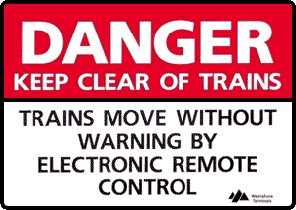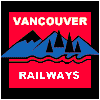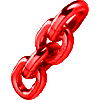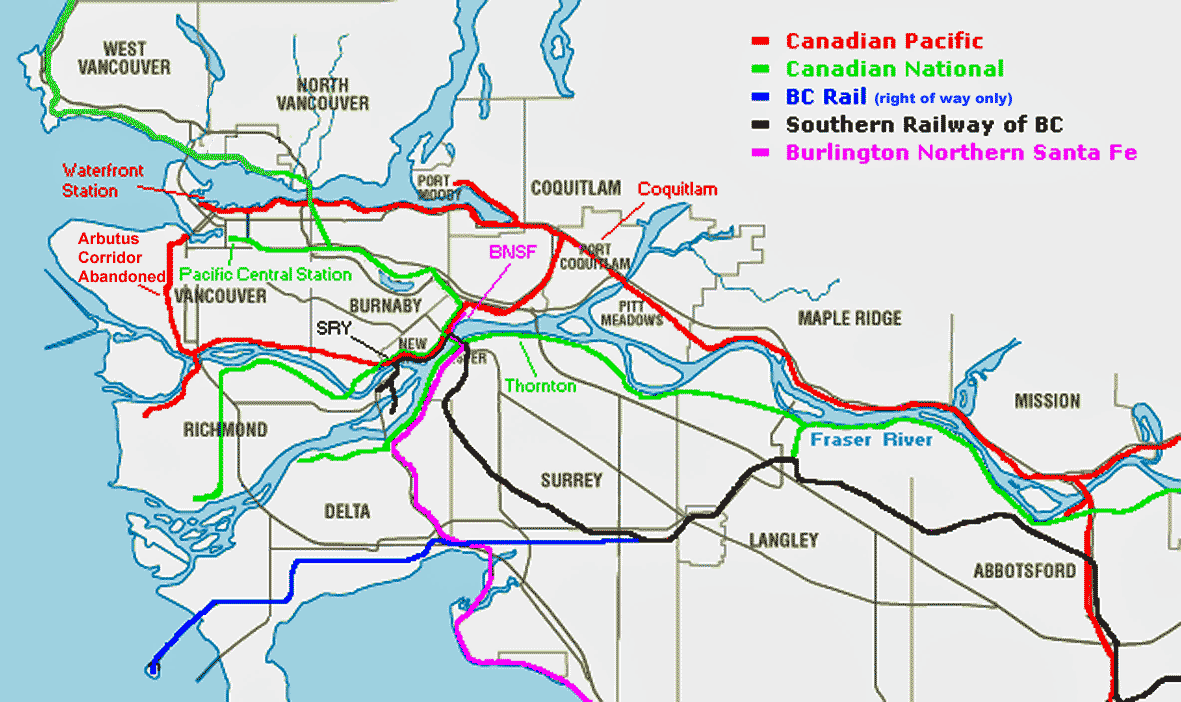So much track is jointly shared by railways within greater Vancouver that it would take a considerable article to explain the intricacies even if they were completely understood. This brief look at the Vancouver lines does not go into that detail.
Canadian National Railways was formed by the Federal government from several failing railways between 1918 and 1923. It was privatized in 1995 and is now one of this country's two transcontinentals. The railway enters greater Vancouver following the Thompson and Fraser Rivers from the east. Its mainline traces the south bank of the Fraser River from Hope, Chilliwack, and Mission, terminating at Thornton Yard in Port Mann across the river from Coquitlam. CN track west of Thornton Yard connects to other railways which fan out to the west and south.
The photograph of Thornton Yard was taken from the Port Mann bridge looking west and shows the main portion known as "PF" yard. The yard also continues some distance on the east side of the bridge and is named "PA" yard. The locomotive servicing area is located in the far distance where the tracks disappear to the left around the trees. New Westminster appartment towers may be seen on the skyline across the Fraser. The City of Coquitlam is off to the right on the other side of the Fraser. Chekc out this photo of the Thornton Yard Complex sign
Yard was taken from the Port Mann bridge looking west and shows the main portion known as "PF" yard. The yard also continues some distance on the east side of the bridge and is named "PA" yard. The locomotive servicing area is located in the far distance where the tracks disappear to the left around the trees. New Westminster appartment towers may be seen on the skyline across the Fraser. The City of Coquitlam is off to the right on the other side of the Fraser. Chekc out this photo of the Thornton Yard Complex sign .
.
Thornton Yard is NOT friendly to railfans. It is well patrolled by CN police and you are advised to stay off the property. A telephoto lens will get you photographs without trespassing. Click on the title above to see a map of the area.
Canada's first transcontinental railway, Canadian Pacific (CP), (OK, let's not split hairs over this. Technically... the line would have to run from sea to sea to be considered a transcontinental, but CP doesn't quite reach Saint John, New Brunswick, anymore as it now uses New Brunswick Southern trackage.) connected this country east and west in 1887 playing a large part in the confederation of Canada. It too arrives in Vancouver via the Thompson and Fraser Canyons. Unlike the CN it takes the north side of the Fraser River from Hope through Agassiz, Mission City, and Haney to reach Coquitlam Yard at Port Coquitlam. Mission City is the junction with CN for the co-production trackage through the Fraser and Thompson Canyons. There is also a large intermodal facility at Pitt Meadows. There are two road entrances to Coquitlam Yard located along Highway 7, at Oxford Street and Coast Meridian Road. The current policy regarding photographing within the yard is unknown so check with CP police or the Yard Office first. In the past it was permitted if one signed a release but I suspect it's not allowed anymore. Coast Meridian Road overpass near the center of the yard gives a good view of the turntable, locomotive shop, and yard trackage.
As the center of CP operations various switching assignments leave and depart here for other areas of greater Vancouver. Esquimalt & Nanaimo Railway (E&N Railfreight) units 3004 and 3005, re-patriated from Vancouver Island, were found switching cars in New Westminster beneath the concrete "Sky Train" guideway along the city's waterfront. Number 3005, a GP38AC, was rebuilt into their so-called Multi Purpose Machine (MPM)
3004 and 3005, re-patriated from Vancouver Island, were found switching cars in New Westminster beneath the concrete "Sky Train" guideway along the city's waterfront. Number 3005, a GP38AC, was rebuilt into their so-called Multi Purpose Machine (MPM) for Maintenance of Way purposes. Ex-E&N 3004 was last seen working at Moose Jaw still wearing CP's paint scheme with the golden beaver applied in April 2005.
for Maintenance of Way purposes. Ex-E&N 3004 was last seen working at Moose Jaw still wearing CP's paint scheme with the golden beaver applied in April 2005.
At one point in Vancouver's history it was serviced by a large interurban electric system known as the British Columbia Electric Railway Company (BCER) which had rail lines running as far east as Chilliwack. These were absorbed by BC Hydro, a Provincial Crown Corporation, in 1961. A lot of this interurban trackage is now operated by the Southern Railway of British Columbia (SRY), a private shortline railroad which took over in 1988. SRY is an American company owned by the Washington Group of companies. SRY headquarters and shops are located on the North Arm of the Fraser River squeezed between the north side of the river and Marine Drive where the road is intersected by the Queenborough Bridge. SRY operates over 125 miles of track and interchanges with CP, CN, and BNSF.
On one particular day the Green Kid was switching several cars within the SRY yard during its fifteen day demonstration lease with SRY. The Green Kid, less powerful than the Green Goat
was switching several cars within the SRY yard during its fifteen day demonstration lease with SRY. The Green Kid, less powerful than the Green Goat , is a hybrid switcher of 1,000 horsepower manufactured by Railpower Technologies Corporation of North Vancouver. (RailPower became bankrupt and was acquired by R.J. Corman Railroad Group in 2009.) A small diesel powered generator keeps specially designed lead acid batteries charged which in turn provide power to the traction motors. After its demonstration with SRY, the Green Kid entered a demonstration lease in mid to late September with the US Marines at the Marine Corp Logistics Base in Barstow, California. Railpower then began the construction of 2 additional Green Goats and 3 additional Green Kids. These next generation locomotives incorporated all of the design improvements generated from testing of the Green Goat and the commissioning of the Green Kid.
, is a hybrid switcher of 1,000 horsepower manufactured by Railpower Technologies Corporation of North Vancouver. (RailPower became bankrupt and was acquired by R.J. Corman Railroad Group in 2009.) A small diesel powered generator keeps specially designed lead acid batteries charged which in turn provide power to the traction motors. After its demonstration with SRY, the Green Kid entered a demonstration lease in mid to late September with the US Marines at the Marine Corp Logistics Base in Barstow, California. Railpower then began the construction of 2 additional Green Goats and 3 additional Green Kids. These next generation locomotives incorporated all of the design improvements generated from testing of the Green Goat and the commissioning of the Green Kid.
Burlington Northern Santa Fe (BNSF) maintains a small wood frame station in New Westminster not far from the old penitentiary along the banks of the Fraser River south of Braid Street. The same jail where Canadian Pacific train robber Bill Miner served some time. Switchers have been stationed here since the line was owned by the Great Northern Railway (GN). In the past the occasional BNSF locomotive would arrive in the modified Santa Fe paint scheme but today most wear the "pumpkin" livery.
BNSF shares trackage from Braid to Pacific Central station located on Main Street near the downtown core of Vancouver. Amtrak trains utilize this joint trackage on their travels south to Seattle, Washington, and Portland, Oregon. Spanish designed Talgo passenger equipment, known as the Amtrak Cascades , is pulled by North American diesels operating on this route. A derailment at Dupont, south of Tacoma where 3 people died, caused the American National Transportation Safety Board to recommend Talgo VI trainsets be taken out of service. Replacement trainsets are expected to arrive sometime in September 2020. Currently, Amtrak service north of Seattle across the Canadian/US border to Vancouver is shut-down due to the COVID-19 pandemic.
, is pulled by North American diesels operating on this route. A derailment at Dupont, south of Tacoma where 3 people died, caused the American National Transportation Safety Board to recommend Talgo VI trainsets be taken out of service. Replacement trainsets are expected to arrive sometime in September 2020. Currently, Amtrak service north of Seattle across the Canadian/US border to Vancouver is shut-down due to the COVID-19 pandemic.
VIA Rail's Canadian also uses the route from the Fraser River bridge as the Amtrak Cascades train to reach Pacific Central Station . VIA's western maintenance
. VIA's western maintenance facility is located a train's length east of Pacific Central station. Large sheds provide cover for servicing and maintenance of equipment during Vancouver's rainy season.
facility is located a train's length east of Pacific Central station. Large sheds provide cover for servicing and maintenance of equipment during Vancouver's rainy season.
In the past the Pacific Great Eastern Railway (PGE) ran from North Vancouver to Prince George and Fort Nelson near the northern border of the province. The provincially owned PGE morphed into the British Columbia Railway (BCoL), or BC Rail. In 2004 the government leased the line to Canadian National for 999 years, except for a small portion connected to Roberts Bank super port.
The old steam shop , which once serviced the Royal Hudson
, which once serviced the Royal Hudson CP 3716, and Hudson 2816 steam locomotives, west of the station on Pemberton Street in North Vancouver, was demolished. Today diesel locomotives rest in the open and much track has been re-aligned around the area over the years. One BC Rail unit and slug
CP 3716, and Hudson 2816 steam locomotives, west of the station on Pemberton Street in North Vancouver, was demolished. Today diesel locomotives rest in the open and much track has been re-aligned around the area over the years. One BC Rail unit and slug may be seen working the yard by the Lions Gate Bridge in the attached photos.
may be seen working the yard by the Lions Gate Bridge in the attached photos.
West Coast Express (WCE) is Vancouver's version of Government of Ontario Transit (GO). It utilizes similar Bombardier built bi-level commuter coaches between Canadian Pacific's old downtown station, now called Waterfront Station, and Mission, 32 miles to the east, pulled by F59PHI locomotives. Trains run entirely on CP trackage and are crewed by CP running trades as CP has the contract to operate this service.
Five trains depart Mission inbound each weekday only to return outbound each weekday evening. During the day the trainsets rest in CP's yard by Cordova Street surrounded by tracks full of containers on flat cars.
Street surrounded by tracks full of containers on flat cars.
On one particular day a "Sounder" locomotive from Seattle, Washington, saw regular service pulling a WCE trainset. Unit SDRX 906 was on long term lease as back-up to the five Canadian WCE units when maintenance made them unavailable. This lease, with an original term of two years, was extended into a third year.

So far there has been only brief mention of Roberts Bank super port. Originally built as a coal trans-shipment facility for CP unit coal trains from the interior mines of British Columbia it has since expanded to handle a huge volume of container traffic.
from the interior mines of British Columbia it has since expanded to handle a huge volume of container traffic.
The port is reached by BC Rail's Port Subdivision, owned by the provincial government. This line runs east from Roberts Bank to a junction with the SRY near Cloverdale and named Pratt on railway timetables. Tracks jut out into the Strait of Georgia on a narrow man-made peninsula . Several signs stating, trains move without warning by electronic remote control, are posted along its length. There was once an Omni-Trax switcher working the tracks here at one time.
. Several signs stating, trains move without warning by electronic remote control, are posted along its length. There was once an Omni-Trax switcher working the tracks here at one time.
Also deserving mention is trackage once owned by CP known as the Arbutus Corridor. This was CP's Marpole Spur which once saw BC Electric interurbans
Corridor. This was CP's Marpole Spur which once saw BC Electric interurbans travelling from their car barns beneath Burrard bridge south along this route to Marpole. CP won a law suit against the City of Vancouver over the issue of zoning this corridor. However, making a long story short, the dispute was eventually settled with the City purchasing the right-of-way from CP. The track was removed and the route is currently a cycling path known as the Arbutus Greenway with the possibility of one day becoming an LRV or streetcar route. Keep your fingers crossed.
travelling from their car barns beneath Burrard bridge south along this route to Marpole. CP won a law suit against the City of Vancouver over the issue of zoning this corridor. However, making a long story short, the dispute was eventually settled with the City purchasing the right-of-way from CP. The track was removed and the route is currently a cycling path known as the Arbutus Greenway with the possibility of one day becoming an LRV or streetcar route. Keep your fingers crossed.











